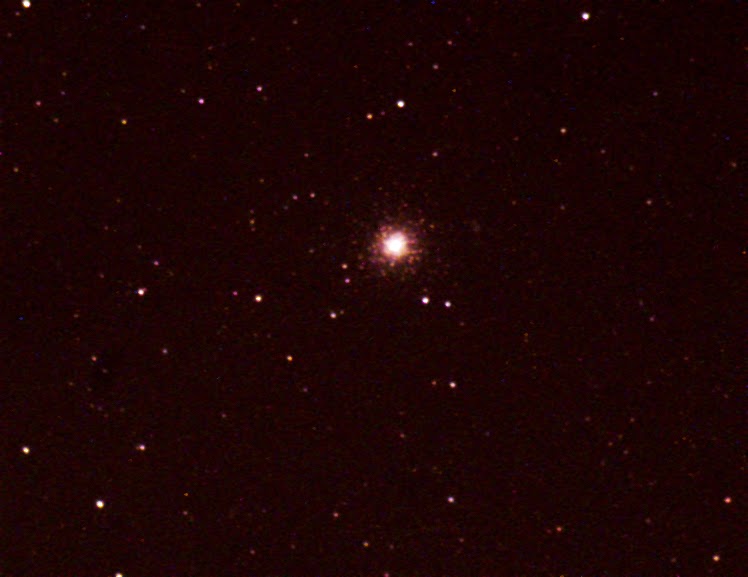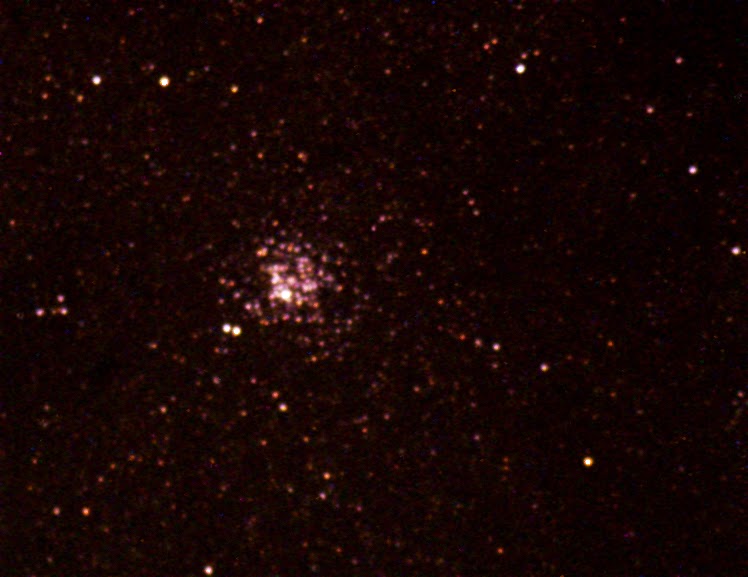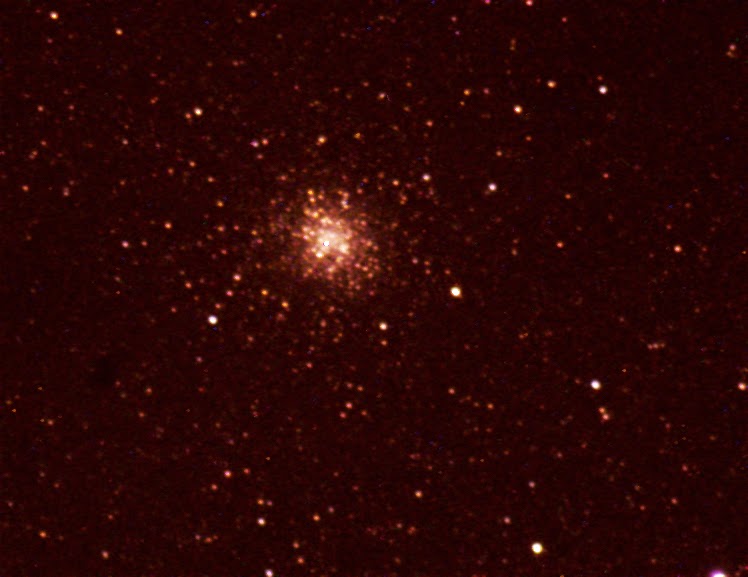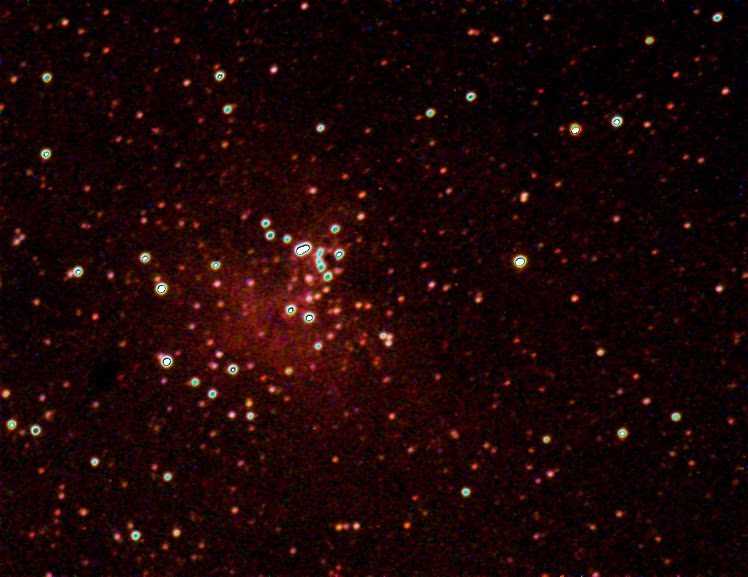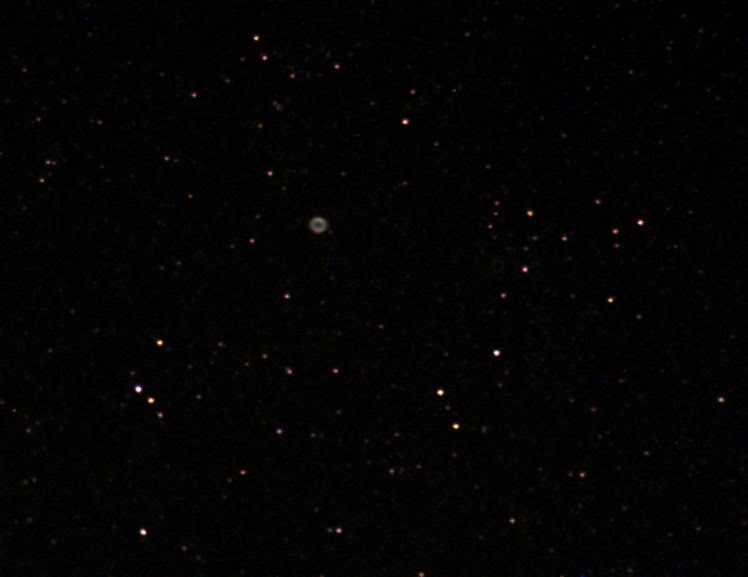The last week (as of middle of August when I started writing this article!) was particularly memorable for me for many reasons, one being in NorCal for my wife's job interviews that went really really well, meaning we would probably be moving up to the bay area soonish. Secondly the glorious deep sky buffet that was served up nightly courtesy of the dark skies (orange bordering on yellow zone) over our friends place in Gilroy, known as the "garlic capital of the world". Gilroy is a nice little agricultural town located about an hour and a half from SF and about 30 minutes drive from San Jose. It is the southernmost city in the Santa Clara County with a population of about 48,821 (2010 census). Due to its fairly rural location (with a surprising number of amenities), the skies are nice and light pollution free. Now I have been here many times to visit our close family friend, but have yet to take advantage of the skies up here. This time, seeing that we were going to be there for at least a week, I made sure I had the correct equipment for observing. I brought along my extremely portable deep sky scope, my Orion SkyScanner 100, a Paragon HDF2 photo tripod and my usual arsenal or accessories, 24.5mm Meade SWA, 13T6 Nagler, 6mm TV Radian, 20mm and 15mm Orion Expanse, and three deep sky filters, my Orion SkyGlow Broadband, DGM Optics NPB UHC and Celestron Baader OIII filter. My plan was to just do pure visual deep sky as I did not want the hassle of having to lug my tracking scope, laptop, batteries, etc for what could be very short stints out to rural dark skies rivaling perhaps Malibu. Turns out the skies here are darker than at Malibu! Views were spectacular towards the south. Light domes were evident over parts of the eastern and northeastern skies. The skies consistently got better after 12 midnight when people went to bed and shops shut for the night. The milky was thick and structured towards the center of our galaxy (Sagittarius-Scorpius region). This time of the year (mid August), the best time to view the center of our galaxy is just after astronomical twilight, which is about 9.30am PST. Even then, Scorpius was starting its slow decent down towards the horizon.
"M2 Globular in Aquarius"
My first two nights was spend observing just outside my friends house on the driveway. Battling light from nearby street lamps, I used my Walking Dead hoodie (sic) as a light shield. Even with the lights shining directly at me, I managed to shield my eyes enough to make out the North American Nebula and the Eastern (NGC 6690) and Western (NGC 6692) portions of the Veil Nebula in Cygnus, which was almost overhead by 10pm. Best views of these two came with the OIII filter. With this filter in place, and using the 24.5mm SWA, I could easily make out the shape of the North American Nebula, and also could recognize the Pelican Nebula! Sweet....
Over the course of the next few nights I would revisit the Veil Nebula. I usually start my scrutiny of the Veil by pointing my scope towards 52 Cygni. This area of the Veil is consistently harder to see as it is fainter. I could just make out the whispy nebulosity running through 52 Cygni with averted vision (the cigarette trailing smoke under night light effect). But as always the eastern portion of the veil showed more texture and mottling. This effect was even more pronounced with the OIII filter in place. I could not visually make out Pickering's Triangle, the middle triangular shaped nebulosity in the Veil. Best views I have ever had of the Veil (the entire complex was visible) was from Leyburn using my 10" f/5 dob and the DGM Optics NPB filter. The Veil looked like a photograph! To me that was the highlight of observing from rural skies. The Veil is not visible from urban skies even with the OIII filter in place.
Down globular alley...
Summertime is also prime hunting time for glorious globular clusters of all shapes and sizes. I visited some of the more notable globulars, that I go back to time and time again (all show some sort of resolution in smallish scopes). Past experience has shown me that in order to fully appreciate the diversity between different globulars, one has to use a minimum of 150mm (6") as it is at this aperture that even the run of the mill globulars start breaking out into stars at high magnification. However even with a small 4" scope, several globulars show partial resolution, and hence individual characteristics. Globulars that I recommend for small scopes include M22, the Crackerjack cluster in Sagittarius; M4 in Scorpius; M10 and M12 in Ophiuchus; M13 in Hercules and M71 in Sagitta. All of them look different under high magnification. There are several others worth looking at, but these appear as mere smudges with little or no resolution. these include M28 in Sagittarius, M15 in Pegasus and M2 in Aquarius.
"M11 The Wild Duck cluster in the glorious Scutum area"
Many hail M13 in Hercules as the best globular for northern hemisphere observers. I beg to disagree. In my opinion, two globulars beat M13 to the punch, M22 in Sagittarius and M5 in Serpens. Both show more resolution in small scopes in comparison to M13. M22, my favourite northern sky globular would be rated more highly if it resided higher in the sky. Having observed this huge globular from the equator and from the southern hemisphere on multiple occasions, I am intimately familliar with it. M22 is very easy to find, being only a slightly to the right of the topmost star of the teapot cover. In my SkyScanner, at 67x magnification, the globular is nicely resolved (almost fully). Individual stars stream out of a very loose nuclear region. I can just about make out several dark lanes running through the globular. I sometimes compare this globular to Omega Centauri at low magnification from the southern hemisphere. Both appear very similar and look more like open clusters at very high magnification. There is almost no core as stars are resolved even at the heart of these globulars!
Two other globulars on my list that are also very loose include M4 and M71. Both are very easy to find. First look for Antares at the heart of the Scorpion. This ruddy star forms an almost vertical line with two other stars, to the top and bottom of Antares. M4 forms a shallow triangle to the right of Antares and the topmost star. As the individual stars in M4 have high horizontal branch magnitude, this globular is very easy to resolve. Scopes as small as 76mm can resolve the "bar of stars" crossing the heart of this cluster (one of the first globular clusters I ever resolved, the first being M22 in my 76mm Newtonian from my balcony back in Vincent Street, Indooroopilly, Australia). Because of this "bar" the cluster has been called the "Cat's Eye Cluster" as it looks distinctly like the slit in a cats eye. M71, located in the rich region in Sagitta looks more like a compact open cluster than a globular. This cluster, like M4 is also easy to resolve at high magnification.It is also ridiculously easy to find. Its located very close to the middle star in the constellation.
"The best northern globular IMHO. M22 The Crackerjack cluster in Sagittarius"
Moving north of the center of our galaxy, we come to the constellation of Ophiuchus, home to many Messier globulars of all shapes and sizes. The two most recognized clusters in this constellation are M10 and M12. Both can be readily distinguished from each other in small scopes as they show some semblence of resolution, although not on the level as the above-mentioned. Still they are rather bright and detailed as globular clusters go.
No survey of summer globulars would be complete without visiting the "so called" king of the northern globulars, M13 in Hercules. This too is extremely easy to locate. All one has to do is locate the keystone at the head of Hercules. Moving south of the topmost-right star of the keystone, you come upon a fuzzy star. M13 is tighter than M22 and M4 and shows a rather condensed core at low magnification. This illusion is shattered at high magnification. At 67x in my SkyScanner I can resolve stars from the periphery to the heart of the globular with averted vision, and can make out the propellar shape that the out-curving stars make (this feature is very prominent in scopes 6" and larger). Also like M22, I can just make out some dark lanes crisscrossing the globular.
Glorious ghostly wraiths.....
"M8 The Lagoon Nebula in Sagittarius, best seen in summer!"
With the warm dark nights in the northern hemisphere, the majestic northern milky way glows softly above, and the center of our galaxy hugging the southern skies its almost impossible to not heed the siren call of the night sky. The sky is peppered with globular clusters, pretty open clusters and some of the finest emission, dark nebulae and supernova remnants in the northern hemisphere. Two of these have already been mentioned. The best place to view such spectacular showpieces nebulae is Sagittarius. Looking towards the heart of our galaxy, in the Sagittarius-Scorpius region, one can just make out the celestial puff of smoke at the tip of the sprout of the teapot shape constellation with the naked eye. This is M8, the Lagoon Nebula, listed as one of the brightest star forming regions after the two top nebulae, Eta Carina, only visible to southern hemisphere observers, and M42, the great nebula in Orion. M8 looks best in a wide field scope as its nebulosity covers an expansive portion of the sky. In the SkyScanner, I can frame M8 and M20, The Trifid Nebula in a single FOV. I find using the UHC type filters counter intuitive from darker skies as it just darkens the views too much. The nebula looks the best framed by bright stars. To see detail however, its best to use magnifications of about 50x, with a UHC type filter. At such magnification, the dark lane that gives it the lagoon moniker comes alive. Dark lanes snake their way through bright nebulosity. Also the hourglass nebula is bright and clear at the heart of the brightest portion of the nebula.
The same can be said for the other bright emission nebulae that pepper the area around Sagittarius. To the north of M8, the delicate Trifid Nebula is also best seen at higher magnification, with the NPB filter. Under low magnification, all you can see is a faint fuzzball surrounding a double star. The dark lanes that give the Trifid its name is best seen at higher magnifications, with the NPB filter in place. A harder thing to spot is its reflection nebula component as this is not enhanced by line filters. For this purpose, I use the broadband filter. In fact from darker skies, sometimes I prefer using this filter over the narrowband filter as it does not affect the brightness of the stars too much.
"M20 The Trifid Nebula is frames nicely with M8 in RFTs"
Two of the remaining bright emission nebulae also look the best under medium to high magnification. M17, the Swan Nebula is one of my favourite nebulae due to its high surface brightness and the intricate detail it presents to curious eyes. This detail is visible even in small telescopes. The main body of the swan looks feathery in my 13T6 Nagler at 30x magnification. The head and neck regions are easy to make out, plus I always feel like I am looking at steam evaporating off the swan's back whenever I look at this object. In my larger scopes, the swans body looks distinctly mottled with brightness variations throughout the body. There is also added swirls of nebulosity behind the swan's main body. Its almost like the wake left in the water as the swan swims through its celestial pond. M16, the Eagle Nebula is harder to see in comparison to all the other nebulae mentioned so far. To the untrained eye, all one can see if the star cluster embedded in its soft swirls. On good transparent nights (such as the nights I had under Gilroy skies!), nebulosity is evident even without a narrowband filter. To me, the faint swirling nebulosity looks more like a ghost, much like how O'Meara describes it in his Deep Sky Companion Messier Objects guidebook. Its famous dark pillars of creation structures are only visible in the largest of scopes (I have seen it with direct vision through a SDM 30" scope at Leyburn and Camp Duckadang in Queensland, Australia!). Detail in this nebula is infinitely easier to detect using CCD imaging...even in scopes as small as 4".
"M16 The Eagle Nebula in Serpens"
Yet another class of objects best seen under summer skies are also classified as nebulae, but rather than representing star birth, these celestial puffballs represent the graveyard of stars. Two of the best examples of planetary nebulae are represented. Everyone has seen and or at least heard of M57, the beautiful Ring Nebula in Lyra. This object is compact, with high surface brightness and therefore punches through light pollution. It also helps that it is one of the easier objects to find in the heavens, since it is located between the bottom two stars in the parallogram that makes up Lyra the harp. This beautiful celestial doughnut is pretty in the smallest scopes. The ring shape is clearly visible even in a 76mm scope. In my 100mm SkyScanner at 50x, I can already make out its ring visage. Under darker skies, a narrowband filter is not really required for a good view.
"M17 The Swan Nebula is just an awesome sight in small scopes. Sagittarius"
In contrast to tiny M57, the other planetary nebula, M27, in the rather obscure constellation of Vulpecula the fox is much larger, and therefore its light is spread out a little bit more. However it is bright enough to be visible form light polluted skies. This one benefits heaps from narrowband filters for light polluted locales. Under dark skies, this object is glorious, appearing more like a hollowed out apple...or and apple core. With the filter in place, its outer nebulosity is visible, making it appear more like a football in my 100mm SkyScanner. To locate this object, I use Sagitta's arrow like stars as a jumping off point. Neighbouriny Vulpecula make a upsidedown W with M27 just south of the middle star in this W shape asterism.
Islands in the stream
"No galaxy pics but then this is summer. M27 The Dumbbell Nebula in Vulpecula the fox"
Summer is not the best month to view galaxies since the thick dust around the center of our home island universe tends to obscure all but the brightest galaxies. This area of the sky is known as the "zone of avoidance". However if you observe early enough, or much later in the evening, you get to gaze at some of the best examples of objects in this class. Early in the evening, look to the north-western sky to spot the big dipper. While technically not in the constellation of Ursa Major, it is easiest to use this constellation as a jumping off point for starhopping. The galaxy I am referring to is M51, the famous Whirlpool Galaxy, another rather high surface brightness object. In fact it is so bright it is even visible in 10x50 binoculars as an oblong shaped smudge. In small scopes, such as my SkyScanner 100, its beautiful face on spiral nature is not visible. All I see is a more magnified odd looking pear shaped object, much like what is visible in binoculars. Spiral structure is hard to detect in scopes smaller than my C8. Use the las star at the end of the big dippers ladle to seek out this object.
The final area of the sky I surveyed is home to one of the brightest object in this class, M31, the Andromeda Galaxy, and its companions galaxies M32 and NGC205. This object is so bright it is easily visible with the naked eye even from less than perfect skies. Under Gilroy's semi rural sky, the galaxy was an easy naked eye catch, even though it was still languishing in the brighter area, with the light dome stretching upwards from the horizon. This galaxy is best seen with wide field scopes and binoculars since it spans a very wide area of the sky (6 full moons diameter). However to see details (i.e. the dark dust lanes), you need more magnification and a larger aperture (I have seen this feature in my C6!). The SkyScanner frames M31 nicely, with its spiral arms stretching out across the FOV. Both satellite galaxies are visible in the same FOV in the 24.5mm Meade SWA. As usual M32 appeared as an intense oval, while NGC 205 was more diffused and harder to pick out. The three form one of the best galaxy groups visible in small scopes, along with the likes of M81/M82, also in Ursa Major.
"Small but one of the prettiest. M57 The Ring Nebula in Lyra"
So that concludes my rural sky observing report. I must confess that I have not been keeping up with my reporting and that there were two more reports that should have been written up. As both were conducted under similar skies, I figured I write a very detailed report to substitute the other two. One session was from Mount Pinos where I had my C8/Vixen Porta Mount and Astroscan with me, a purely visual session, and the other just two weeks ago from Malibu. All images featured here were taken at Malibu with my widefield 70mm TravelScope mounted on the NexStar GT mount. Enjoy....
